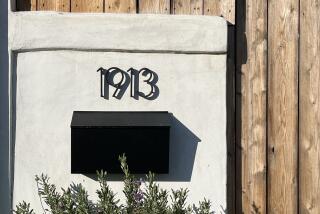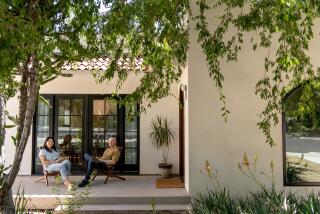Home Style / Entryways : The Doors : Entry Gives 1st Impression of a Home
The entry to your house is its calling card, the first impression it makes upon visitors.
A well-designed approach combined with the right front door can make a statement in keeping with your personality and your home’s design.
Experts agree you will spend at least $1,500 for an entry door of good quality, including installation, hardware and finishing.
Custom doors, such as those by Solana Beach craftsman David Frisk, can cost several times that. His shop is in a converted Quonset hut, where lengths of rare hardwoods lean against the walls and the scent of freshly cut wood is pervasive. Among his creations: a four-panel set of front door screens crafted from exotic hardwoods and depicting egrets standing among reeds.
Building materials outlets, such as Dixieline and Home Depot, and door specialty stores listed in the Yellow Pages, offer more affordable, mass-produced entry doors. Some of these incorporate leaded glass, carving and other detailing that gives them a custom appearance.
Frisk recommends buying only doors made from kiln dried wood, assembled with water-resistant, exterior grade glue. Most major manufacturers don’t cut corners on these items, but some local stores carry imported doors that may or may not live up to these standards.
Many production doors are made from pine or Douglas fir, but Frisk uses maple for his least expensive doors. Oak and mahogany are common and adequate choices for production doors, and teak, although more exotic, is also durable and used for both production and custom doors.
As important as the wood is the way the door is constructed. This is especially true for entry doors with a southern exposure--relentless sunlight wears on wood, glue and finishes.
In general, the more glued surface area, the stronger the door. Frisk uses mortise-and-tenon joinery, whereas many quality production doors use doweled construction; the more dowels, the more surface area, and the stronger the door.
A door’s finish is also crucial. If you decide to paint your entry door, it should be primed with oil-base paint and given two or three finish coats, Frisk advises. He prefers to treat doors with marine-grade varnish: one coat of sealer, three or four glossy coats and a final satin finish. Glossier varnishes last longer than flat finishes, he says.
Several manufacturers make good quality production doors. Among them are Grant, Simpson, Christopher Voorhees, American International Trading, Diversified Multi Resources and International Wood Products, whose high-end, oak entry doors cost about $2,500. Dixieline stocks most of these and can order the rest.
Dixieline also carries the custom Forms + Surfaces line. A pair of contemporary Forms + Surfaces entry doors with hardware could cost $6,000, according to Larry Crawford, division manager at Dixieline’s Classic Collections outlet on Miramar Road.
The Sierra Padre Mill Co. showroom in Encinitas always has more than 20 entry doors on hand by manufacturers including T.M. Cobb, Simpson and California Classics.
Sierra Padre and other suppliers have catalogues from which you can order entry doors if you don’t find what you want in stock. With many warehouses in Los Angeles, you can usually take delivery in a week or two.
While checking out entry doors, also consider the treatment of the indoor and outdoor spaces around it and how they fit with the design and decor of your home.
“It’s the first impression, and it sets the mood for everything to come,” says architect Wallace Cunningham, who uses teak, copper, stainless steel and a variety of other materials for front doors. “An entry can be mysterious, it can give a certain feeling of trying to find the door, going down a path, or up a few stairs. Or it can be classical, marked with columns, with a straight-on approach, a drop-dead, ‘I’m rich’ thing.”
Cunningham said he sometimes uses two sets of doors--modest and plain outside, more elaborate inside. It is a style compatible with the California tradition of courtyard gardens and entry gates that lead into them.
“One client told me how the entry sequence would work. There would be protection from salesmen, protection from people on the street and enough space to greet people outside the door,” he said.
Cunningham describes an elaborate entry he designed for a house at Lake Hodges: “You park your car, go around a wall into a huge courtyard, step between two buildings where there is an incredible vista out to Lake Hodges, go down a series of steps, turn slightly, and there is a glass door you almost seem to float through, then down a few steps and into the living room. You don’t know where the indoor and outdoor spaces begin and end.”
The element of surprise can also add impact to a door, he said.
“Sometimes for drama--especially in situations where you have an incredible view from the entry--if you block the view through the general entry area and have visitors turn a corner or come around something to see the view, it’s like a presentation or unveiling of the view, instead of having it visible all the time.”

